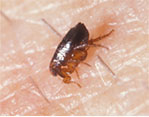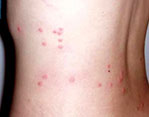Fleas

Cat Flea (Ctenocephalides felis)
The cat flea is small at around 2 mm long, reddish brown in colour and is flattened laterally, a feature which enables it to move easily amongst the hair of its vertebrate host.
The most distinctive features of the cat flea are the large jumping legs and the row of black non-sensory spines on the front margin of the head and on the rear of the first thoracic segment. These bristles or combs are a diagnostic feature of the cat flea.
The eyes are apparent as are the antennae, and the mouthparts, adapted for piercing and sucking, are typically seen projecting downwards from the head.

Where will you find them?
Although the cat and the dog are the preferred hosts for cat fleas – they are capable of feeding on humans, and frequently do. The distress caused by the bites can be considerable in cats and humans. Some people can suffer allergic reactions to bites, resulting in pain and discomfort that is very unpleasant indeed.
Vibration as a trigger for the adults to emerge from the pupa, mentioned above, frequently means that humans who go into empty premises where cats had previously been “in residence” suffer a high level of attack.
How do we control Fleas?
We offer a free of charge survey that is carried out by our trained surveyors. They will offer our proposal and advice as to how to treat and how you can try to reduce the risk of reinfestation in the future.Our technician will initially talk through the problems you are experiencing and explain what our treatment entails. He will then carry out a thorough inspection of your premises prior to any treatment and assess the level and extent of the infestation. Once this has been established, he will carry out treatment to the appropriate areas. Once our treatment is complete we will detail our work in an inspection report and leave this with you, our technician will then arrange a convenient time to carry out a follow up visit.

